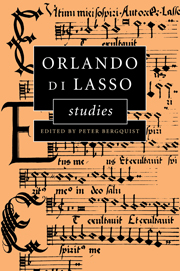Book contents
- Frontmatter
- Contents
- Preface
- List of abbreviations
- 1 Aspects of form in Orlando di Lasso's Magnificat settings
- 2 Orlando di Lasso and Andrea Gabrieli: two motets and their masses in a Munich choir book from 1564–65
- 3 Post-Tridentine liturgical change and functional music: Lasso's cycle of polyphonic Latin hymns
- 4 The salon as marketplace in the 1550s: patrons and collectors of Lasso's secular music
- 5 Lasso's “Standomi un giorno” and the canzone in the mid-sixteenth century
- 6 Lasso's “Fertur in conviviis”: on the history of its text and transmission
- 7 Orlando di Lasso and Rome: personal contacts and musical influences
- 8 Orlando di Lasso as a model for composition as seen in the three-voice motets of Jean de Castro
- 9 The madrigal book of Jean Turnhout (1589) and its relationship to Lasso
- 10 Modal ordering within Orlando di Lasso's publications
- 11 Correct and incorrect accentuation in Lasso's music: on the implied dependence on the text in classical vocal polyphony
- General index
- Index of Lasso compositions and printed sources
11 - Correct and incorrect accentuation in Lasso's music: on the implied dependence on the text in classical vocal polyphony
Published online by Cambridge University Press: 18 December 2009
- Frontmatter
- Contents
- Preface
- List of abbreviations
- 1 Aspects of form in Orlando di Lasso's Magnificat settings
- 2 Orlando di Lasso and Andrea Gabrieli: two motets and their masses in a Munich choir book from 1564–65
- 3 Post-Tridentine liturgical change and functional music: Lasso's cycle of polyphonic Latin hymns
- 4 The salon as marketplace in the 1550s: patrons and collectors of Lasso's secular music
- 5 Lasso's “Standomi un giorno” and the canzone in the mid-sixteenth century
- 6 Lasso's “Fertur in conviviis”: on the history of its text and transmission
- 7 Orlando di Lasso and Rome: personal contacts and musical influences
- 8 Orlando di Lasso as a model for composition as seen in the three-voice motets of Jean de Castro
- 9 The madrigal book of Jean Turnhout (1589) and its relationship to Lasso
- 10 Modal ordering within Orlando di Lasso's publications
- 11 Correct and incorrect accentuation in Lasso's music: on the implied dependence on the text in classical vocal polyphony
- General index
- Index of Lasso compositions and printed sources
Summary
The title of this essay could awaken the impression that there are “correct” and “incorrect” stresses on the words in the vocal polyphony of the sixteenth century, including the works of Orlando di Lasso. This is of course not so, otherwise Lasso and Palestrina and many others would not have been elevated to the ranks of great masters in music. None the less there is something in that formulation. The “correct” text stresses are the usual ones that are arranged in accordance with the musical meter. The so-called “incorrect” stresses are “incorrect” in their relationship to the meter and thus achieve much stronger effects than the “correct” ones. For this reason, infact, the metrically “incorrect” stresses are much less common than the “correct” ones, but they are found in all kinds of works from every period and continue to be reserved for special emphasis. If they were mistakes, one would expect that the masters would gradually have improved them and removed them from use. This is not the case. One who wishes to learn about this distinction may discover it throughout Lasso's work, from the Prophetiae Sibyllarum to the Lagrime di San Pietro, and not in his music alone. That one generally knows nothing of such a distinction, and that one is usually not aware of it, is connected with the circumstance that our mass-music culture transfers its preference for the soft, full, blended sound of the mixed chorus to all music, even the old and the oldest, and the difficulties inherent in these refinements go by the wayside.
- Type
- Chapter
- Information
- Orlando di Lasso Studies , pp. 227 - 246Publisher: Cambridge University PressPrint publication year: 1999



